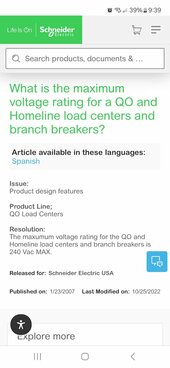Where did you get this information?
They are rated for 240v.
A two pole breaker on a split-phase panel is flowing 240v and will have no problem tripping at 240v. They must be able to trip a line to line (240v) dead short. Same goes for single pole breakers on multi wire branch circuits.
Somewhere I read it explicitly, I thought. Where it is clear but doesn't jump out at you is selection guide and data sheeting saying "240V", not just "120/240V" and "120V", for select models but not others.
In the QO family, all the 3-pole breakers are rated higher per pole, (277V I had thought, not finding now) but definitely 240V per pole.
Select 1-pole and 2-pole breakers of a different model number (contains "V", I think"H") are also rated 277V.
Garden variety QO breakers are only 120V per pole. A 2-pole breaker rated 120/240V is only for individual Ln of 120V. L1 & L2 can be 240V apart, but handles are ganged to trip together so 2 poles in series interrupt 240V.
"What is the maximum allowable ampere and voltage rating of a QO circuit breaker that can be installed"

But that gives breaker panel model line, and mentions maximum voltage rating of breakers but doesn't say all breakers have that voltage rating.
It is very hard to find the info on their website. The following data sheet for QO130 says "120/240V" and "120V". Somewhere we will find this means it can be used in a split-phase 120/240V system, NOT in a 240V single-phase system or as one pole of a 240/480V circuit (do those exist?) and not 277/480Y (of course not, doesn't say 277V). But not for a 240/416Y system, anyway. Where it would see 240V across one pole.
Big confusion there that Schneider says "120/240V" for the single pole breaker. Not meaning it can work at 240V, just that it can be used in a 120/240V system where no line voltage exceeds 120V.
Note QO230 is rated "120/240V" and "120V"
Schneider Electric USA. QO230 - Mini circuit breaker, QO, 30A, 2 pole, 120/240VAC, 10kA, plug in.

www.se.com
Note difference QO230H. It is rated "120/240V",
"240V", and "120V".
Schneider Electric USA. QO230H - Mini circuit breaker, QO, 30A, 2 pole, 120/240VAC, 10kA, plug in.

www.se.com
Same difference for QO330 (doesn't say "H"). It is rated "120/240V",
"240V", and "120V". Doesn't say 208V, but I think it is fine in 120/208Y. Not in 240/416Y.
Schneider Electric USA. QO330 - Mini circuit breaker, QO, 30A, 3 pole, 120/240VAC, 10kA, plug in.

www.se.com
I thought QO panels worked for 277/480, but I'm not finding any QO series 277V, only E-frame bolt on.
Here's one note explicitly mentioning "QO__H" series breakers fully rated 240V, not 120/240V rated breakers, for 3-wire 240V delta.
(That would be a corner grounded delta in a breaker panel with one N and L1, L2, correct? Maybe not - I find 3-phase QO panel boards that say 240 delta, but the ones I've seen with 2 not 3 plug-on busbars only say 120/240V. Strange I can't find anything higher than 120/208Y or 240 delta, when some breakers are rated 240V per pole.)
"
Can an NQ panel be used on a 240V 3PH Delta system ?
Issue:
NQ panelboards rated for a 240V 3 phase 3 wire delta voltage system
Product Line:
Panelboards
Environment:
NQ
Resolution:
Yes. Branch breakers must be 3P or QO--H / QOB--H and must carry a full 240V rating.
NOTE: This is not the same as a 240D/120VAC 3PH 4W system.
https://download.schneider-electric...17.1434407716.1686064075-258592155.1681310191"
so then use one leg of it to switch only L1 is that acceptable? or would be switching L1 and neutral but not the ground be the best?
Reason I ask is I have several 3 phase breakers of varying amperage I picked up used from a recycle shop for pennies. European style 230 single phase is not something I have ever used (or studied or looked into). here in japan its split phase 200 so L1 100 volts, L2 100 volts and neutral.
If one side of inverter (N) is bonded to ground, then only hot L1 has to be switched. The 3 pole QO breakers are all rated at least 240V per pole.
Otherwise, use a QO___H breaker. That's of QO series. Various brand DIN rail including Schneider Multi-9 are rated 277V.
Hey, here's a shunt trip! This could be used with thermostat to cut power to a panel with auto-transformer if transformer overheats.
Schneider Electric USA. QO2301021 - Mini circuit breaker, QO, 30A, 2 pole, 120/240VAC, 10kA, plug in, AC shunt.

www.se.com





